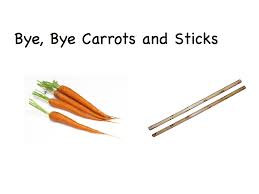One of my elementary school teachers that I most remember is Ms. Selby. She was a good teacher and I learned a lot in her class. And I actually liked her quite a bit…even though she seemed to be in a sour mood most of the time. But what I most remember about Ms. Selby is that she had a thick paddle with holes drilled in it and if you misbehaved badly enough in her class, you would likely feel the sting of her swatting your behind with that paddle.
This type of classroom punishment is no longer used but, “back in the day,” I was on the receiving end of her paddlings a couple of times (completely undeserved, of course). Most of my classmates didn’t cause problems or otherwise misbehave and therefore rarely got spanked, as the mere threat of “the paddle” was sufficient to keep them in line. As a vivid memory of mine, this is an example of motivation by fear where, essentially, our teacher used the threat of pain and embarrassment to keep us 5th graders in line. And, for the most part, it worked.
Then, there was dear, sweet Ms. Cunningham who was forever cajoling her students with candy and extended play periods if we would complete our homework assignments on time and behave in class. Like Ms. Selby’s, her approach also resulted in a fairly well-behaved classroom, much because the rewards were sufficient to alter the actions of some who would have otherwise misbehaved or not minded. Ms. Cunningham’s methods are a simple example of motivation by incentive.
Traditional Types of Motivation
Each of these types of motivation (by fear and by incentive) is based on external factors (spankings and sweets, in my examples) to get a desired result. These two types of motivation are also found extensively in the workplace, where disapproving comments, threats of repercussions, and exhortations of “do better or else” occur regularly. Similarly, it is common practice that bonuses, award trips, kudos, and other forms of compensation and recognition are used to motivate employees. The issue is that, since these forms of motivation are based on external factors, the employee’s modified behavior (to avoid the negative repercussion or to achieve the benefit) is often short-lived.
The very essence of fear is negative, and any results produced under the stress of fear is typically sub-optimal at best. Many of the same kids who behaved well enough in Ms. Selby’s class, misbehaved in other classes. Their improved classroom behavior was situational and not long-lasting. Likewise, many students in Ms. Cunningham’s class acted well enough to get the rewards that were being offered, but behaved less appropriately when there were no special incentives. Again, parallels can easily be drawn with situations at work where employees change their behaviors depending on which of these two traditional types of motivation is utilized. Fear and incentive motivation are both frequently used in the workplace, but typically have less than lasting results.
The Power of Attitude Motivation
As the modern workforce changes and evolves, incentive and fear motivation (the carrot and stick) are no longer as effective as they once were. And their motivational power diminishes after the promised reward has been gained or the threatened penalty has been avoided. A more powerful and sustainable form of motivation, motivation by attitude, motivates successful employees. When you are motivated from within, you are less dependent on other people or things to motivate you. You are driven by a belief in yourself, your dreams, and your goals, as you strive to maximize your potential. You want to achieve because that’s your life’s purpose, not simply because you want to gain an external reward or avoid a loss or punishment.
Motivation by fear is about avoiding.
Motivation by incentive is about getting.
Motivation by attitude is about becoming. When your goal is to become the best you can be, you will be self-motivated to exceed even your own expectations!
There’s a simple definition for this complex subject: “Self-motivation is an inner drive that compels behavior.” What makes it complex, however, is that little word “inner,” because what works for me may not work for you, and vice-versa. Everyone needs to determine for themselves what drives them and how they will act on it.
What are your opinions about these various types of motivation?

